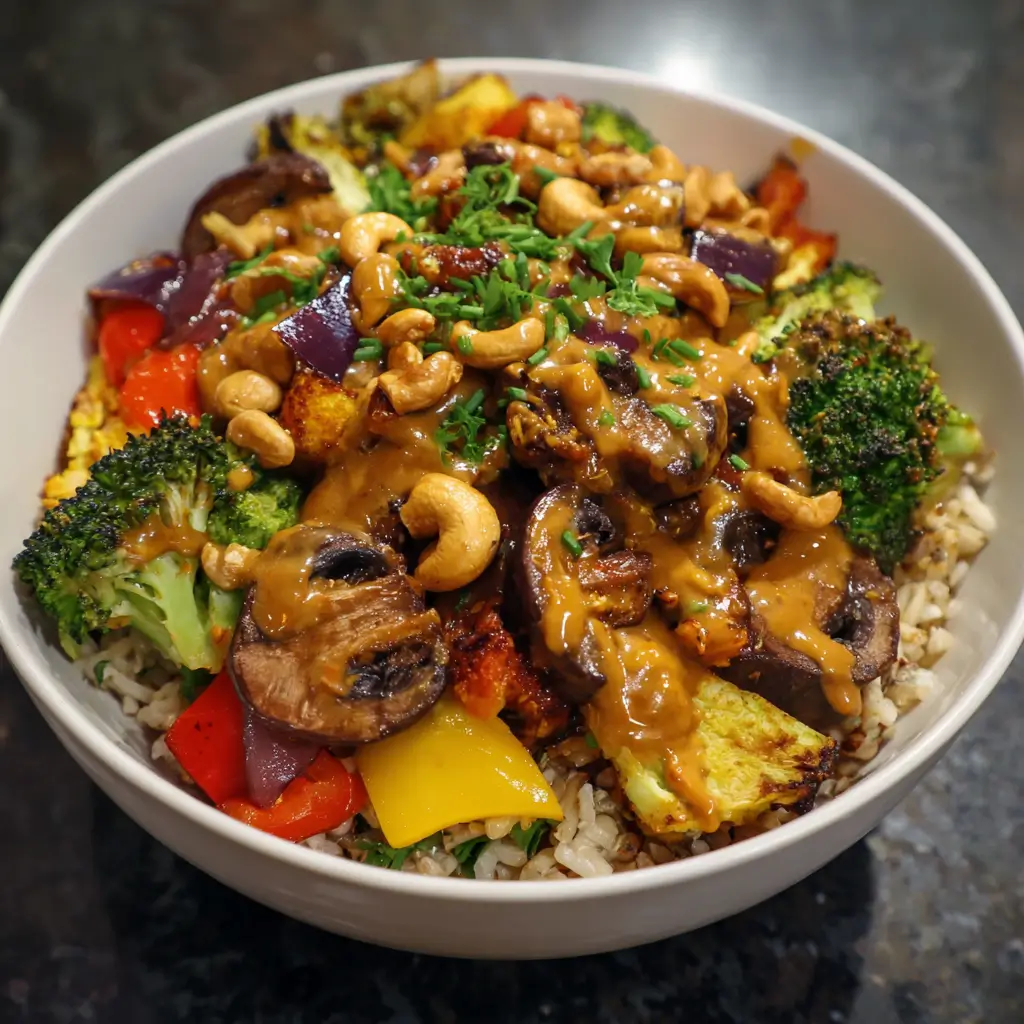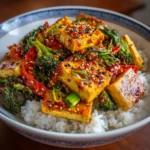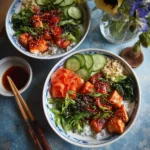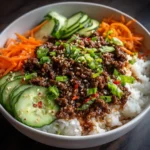Introduction
Vegetable Stir Fry with Cashew Sauce is a vibrant, nutrient-packed dish that brings together the bold flavors of Asian-inspired cuisine with the creamy richness of cashews. This versatile and satisfying meal is perfect for busy weeknights, health-conscious eaters, or anyone craving a delicious plant-based option that doesn’t skimp on taste. Whether you’re a seasoned home cook or just beginning your culinary journey, this stir fry offers an easy-to-follow recipe that’s both flavorful and nourishing. The smooth, velvety cashew sauce elevates the medley of colorful vegetables, creating a harmonious balance of textures and tastes that will leave your taste buds tingling. Not only is it a feast for the palate, but it’s also visually stunning—bright bell peppers, tender broccoli, crisp snap peas, and golden tofu come together in a glossy, aromatic sauce that glistens under the light. Best of all, this dish is endlessly customizable, making it ideal for accommodating dietary preferences and using up seasonal produce.
The History
Stir frying has its roots deep in Chinese culinary tradition, dating back over 2,000 years to the Han Dynasty. The technique was developed as a practical method of cooking food quickly over high heat using minimal oil, which preserved nutrients and enhanced flavor. Over centuries, stir frying spread throughout East and Southeast Asia, evolving with regional ingredients and spice profiles. While traditional stir fries often featured meat and soy-based sauces, modern adaptations have embraced vegetarian and vegan variations to meet changing dietary trends and global palates. The use of cashews in savory dishes can be traced to regions where cashew trees are cultivated, such as India, Vietnam, and parts of West Africa. However, their integration into stir fry sauces gained popularity more recently, particularly within Western fusion cuisine and plant-based cooking movements. Chefs and home cooks began experimenting with blending soaked cashews into creamy sauces as a dairy-free alternative to heavy creams and cheeses. This innovation led to the creation of luxurious, allergen-friendly sauces that mimic the richness of traditional cream-based gravies without compromising on texture or depth. Today, Vegetable Stir Fry with Cashew Sauce stands at the intersection of ancient cooking techniques and contemporary wellness-focused gastronomy, symbolizing how global food traditions continue to evolve and inspire new generations of healthy, sustainable eating.
Ingredients Breakdown
The beauty of this Vegetable Stir Fry with Cashew Sauce lies not only in its flavor but also in the wholesome, nutrient-dense ingredients that come together to create a balanced and satisfying meal. Let’s take a closer look at each component:
- Cashews (raw, unsalted): The star of the sauce, raw cashews are rich in heart-healthy monounsaturated fats, magnesium, copper, and plant-based protein. When blended with liquid, they transform into a luxuriously creamy base without the need for dairy.
- Garlic and Ginger: These aromatic powerhouses not only add depth and warmth to the sauce but also boast anti-inflammatory and immune-boosting properties.
- Soy Sauce or Tamari: Provides umami and saltiness; tamari is a gluten-free alternative ideal for those with sensitivities.
- Rice Vinegar or Apple Cider Vinegar: Adds a subtle tang that balances the richness of the cashew sauce.
- Maple Syrup or Agave Nectar: A touch of natural sweetness enhances flavor complexity and helps caramelize vegetables slightly during stir-frying.
- Sesame Oil: Used sparingly for its intense nutty aroma, especially when added at the end of cooking.
- Vegetables: A rainbow mix including broccoli florets, red bell pepper, carrots, snap peas, mushrooms, zucchini, and baby corn provides fiber, vitamins (A, C, K), antioxidants, and phytonutrients. Feel free to swap based on seasonality.
- Tofu or Tempeh (optional): Adds plant-based protein; extra-firm tofu holds up well in stir-fries when pressed and cubed.
- Green Onions and Red Chili Flakes: For garnish and a hint of heat and freshness.
- Cooking Oil (avocado, grapeseed, or peanut oil): High smoke point oils are essential for stir-frying at high temperatures without burning.
- Cornstarch or Arrowroot Powder: Helps thicken the sauce naturally for a glossy, restaurant-quality finish.
Each ingredient plays a role in building layers of flavor, texture, and nutrition, making this dish a true celebration of whole-food, plant-forward cooking.
Step-by-Step Recipe
- Prepare the Cashew Sauce: Soak 1 cup of raw cashews in hot water for at least 30 minutes (or overnight in room-temperature water). Drain and transfer to a high-speed blender. Add ¾ cup warm water, 3 tablespoons soy sauce or tamari, 2 tablespoons rice vinegar, 1 tablespoon maple syrup, 2 cloves minced garlic, 1 tablespoon grated fresh ginger, and 1 teaspoon cornstarch. Blend until completely smooth and creamy, about 1–2 minutes. Set aside.
- Press and Prepare Tofu (if using): Cut 14 oz block of extra-firm tofu into ½-inch cubes. Wrap in paper towels or a clean kitchen cloth and place a heavy object on top (like a skillet) for 15–20 minutes to remove excess moisture. Once pressed, toss with 1 tablespoon soy sauce and 1 teaspoon cornstarch for crispiness.
- Chop the Vegetables: Wash and cut 2 cups broccoli florets, 1 sliced red bell pepper, 1 julienned carrot, 1 cup snap peas, 1 sliced zucchini, 1 cup sliced mushrooms, and ½ cup canned baby corn (drained). Keep them separated by cooking time—harder veggies like carrots and broccoli go first.
- Stir-Fry the Tofu (optional): Heat 1 tablespoon avocado oil in a large wok or non-stick skillet over medium-high heat. Add tofu cubes and cook for 4–5 minutes per side until golden brown. Remove and set aside.
- Begin Stir-Frying Vegetables: In the same pan, add another tablespoon of oil. Start with harder vegetables—add broccoli and carrots first, stir-fry for 3–4 minutes until slightly tender. Add bell peppers and mushrooms, cook another 2–3 minutes.
- Add Softer Vegetables: Toss in snap peas, zucchini, and baby corn. Cook for 2–3 minutes until vibrant and crisp-tender. Avoid overcooking to preserve texture and nutrients.
- Incorporate the Sauce: Pour the prepared cashew sauce into the pan. Stir gently to coat all vegetables evenly. Bring to a gentle simmer and cook for 2–3 minutes until the sauce thickens and clings beautifully to the veggies.
- Return Tofu to Pan: Add the cooked tofu back into the stir fry and stir to combine. Warm through for 1 minute.
- Finish with Flavor: Drizzle with 1 teaspoon toasted sesame oil and sprinkle with red chili flakes for heat, if desired.
- Serve Immediately: Plate over steamed jasmine rice, brown rice, quinoa, or noodles. Garnish with sliced green onions and extra cashews for crunch.
Tips
- Soak Cashews Properly: For the silkiest sauce, soak cashews in boiling water for 30 minutes or in room-temperature water for 4+ hours. This ensures no graininess in the final sauce.
- Prep Ahead: Chop all vegetables and make the sauce in advance. Store separately in the fridge for quick assembly during busy days.
- High Heat is Key: Stir frying requires high heat to achieve that signature “wok hei” (breath of the wok)—the smoky, charred flavor. Use a gas stove if possible, or preheat your pan thoroughly.
- Don’t Crowd the Pan: Cook in batches if necessary. Overcrowding lowers the temperature and causes vegetables to steam instead of sear.
- Adjust Sauce Consistency: If the sauce is too thick after blending, add water 1 tablespoon at a time. If too thin during cooking, let it simmer longer or add a slurry of ½ teaspoon cornstarch + 1 tablespoon water.
- Boost Umami: Add 1 teaspoon miso paste or ½ tablespoon nutritional yeast to the sauce for deeper savory notes.
- Toast the Cashews (Optional): For added depth, lightly toast cashews before soaking—but don’t skip soaking for sauce applications.
- Use Frozen Veggies in a Pinch: Mixed stir-fry blends from the freezer section work well; just thaw and pat dry to prevent sogginess.
Variations and Customizations
This Vegetable Stir Fry with Cashew Sauce is incredibly adaptable to suit different tastes, diets, and pantry contents:
- Protein Variations: Swap tofu for tempeh, seitan, edamame, chickpeas, or even shredded chicken or shrimp for non-vegetarian options.
- Nut-Free Version: Replace cashews with sunflower seeds or white beans (like cannellini) for a creamy, allergy-safe sauce.
- Low-Sodium Option: Use low-sodium tamari or coconut aminos instead of regular soy sauce.
- Spicy Kick: Add sriracha, sambal oelek, or chopped fresh Thai chilies to the sauce for heat lovers.
- Gluten-Free Friendly: Ensure tamari is used instead of soy sauce, and verify all other ingredients are certified gluten-free.
- Seasonal Swaps: In spring, use asparagus and snow peas; in fall, try sweet potatoes and Brussels sprouts; winter calls for kale and cabbage.
- Creamier Texture: Add 2 tablespoons coconut milk to the cashew sauce for extra silkiness.
- Herb Infusion: Stir in fresh cilantro, Thai basil, or mint just before serving for a burst of aromatic freshness.
- Noodle Bowl Style: Serve over rice noodles, udon, soba, or even spiralized zucchini for a low-carb option.
- Buddha Bowl Makeover: Turn it into a grain bowl with quinoa, avocado slices, pickled vegetables, and a soft-boiled egg or marinated lentils.
Health Considerations and Nutritional Value
Vegetable Stir Fry with Cashew Sauce isn’t just delicious—it’s a powerhouse of nutrition designed to support overall well-being. Here’s a breakdown of its health benefits:
- Heart-Healthy Fats: Cashews provide monounsaturated and polyunsaturated fats, which help reduce bad cholesterol levels and lower the risk of heart disease.
- Rich in Plant-Based Protein: With tofu and cashews, this dish delivers around 12–18 grams of protein per serving, supporting muscle repair and satiety.
- High Fiber Content: Thanks to a wide variety of vegetables and optional whole grains, this meal promotes digestive health and helps regulate blood sugar levels.
- Vitamins and Minerals Galore: Carrots offer beta-carotene (vitamin A), bell peppers are loaded with vitamin C, broccoli contains vitamin K and folate, while mushrooms contribute B vitamins and selenium.
- Anti-Inflammatory Properties: Garlic, ginger, and turmeric (if added) have been shown to reduce inflammation, potentially lowering the risk of chronic diseases.
- Dairy-Free and Vegan: Perfect for those avoiding animal products due to lactose intolerance, ethical choices, or environmental concerns.
- Low Glycemic Index: Especially when served with brown rice or quinoa, this dish provides sustained energy without spiking insulin levels.
- Antioxidant-Rich: Colorful vegetables contain phytochemicals like lycopene, anthocyanins, and flavonoids that combat oxidative stress.
Nutritional Estimate (per serving, serves 4): Approximately 320–380 calories, 16g fat (mostly healthy fats), 14g protein, 40g carbohydrates, 8g fiber, 9g sugars (naturally occurring), 600–800mg sodium (adjustable), 15% DV iron, 20% DV calcium, 100% DV vitamin C, 40% DV vitamin A.
Note: Sodium content depends on soy sauce choice; using coconut aminos reduces sodium significantly. Always consult a healthcare provider for personalized dietary advice, especially if managing conditions like kidney disease, nut allergies, or diabetes.
Ingredients
For the Cashew Sauce:
- 1 cup raw, unsalted cashews (soaked)
- ¾ cup warm water
- 3 tbsp soy sauce or tamari (gluten-free if needed)
- 2 tbsp rice vinegar or apple cider vinegar
- 1 tbsp pure maple syrup or agave nectar
- 2 cloves garlic, minced
- 1 tbsp fresh ginger, grated
- 1 tsp cornstarch or arrowroot powder
For the Stir Fry:
- 1 tbsp avocado oil or peanut oil (divided)
- 14 oz extra-firm tofu, pressed and cubed (optional)
- 2 cups broccoli florets
- 1 red bell pepper, sliced
- 1 large carrot, julienned or thinly sliced
- 1 cup sugar snap peas
- 1 cup sliced mushrooms (shiitake or cremini)
- 1 small zucchini, sliced
- ½ cup baby corn, drained
- Salt and black pepper to taste
For Garnish and Finish:
- 1 tsp toasted sesame oil
- 2 green onions, sliced
- 2 tbsp roasted cashews, chopped
- Red chili flakes (optional)
Directions
- Soak cashews in hot water for 30 minutes. Drain and blend with warm water, soy sauce, vinegar, maple syrup, garlic, ginger, and cornstarch until smooth. Set sauce aside.
- If using tofu, press between towels for 15–20 minutes. Cut into cubes, toss with 1 tbsp soy sauce and 1 tsp cornstarch. Heat ½ tbsp oil in a wok or large skillet over medium-high heat. Add tofu and cook until golden on all sides, about 8–10 minutes. Remove and set aside.
- Heat remaining oil in the same pan. Add broccoli and carrots; stir-fry for 3–4 minutes until bright and slightly tender.
- Add bell pepper and mushrooms; cook for another 2–3 minutes, stirring constantly.
- Toss in snap peas, zucchini, and baby corn. Cook for 2–3 minutes until vegetables are crisp-tender.
- Pour in the cashew sauce. Stir well to coat. Simmer gently for 2–3 minutes until sauce thickens and bubbles around the edges.
- Return tofu to the pan. Stir to combine and heat through for 1 minute.
- Remove from heat. Stir in toasted sesame oil. Taste and adjust seasoning with salt, pepper, or extra soy sauce if needed.
- Serve immediately over rice or noodles. Garnish with green onions, chopped cashews, and a pinch of red chili flakes.
FAQ
Can I make this stir fry ahead of time?
Yes! You can chop vegetables and prepare the cashew sauce up to 2 days in advance. Store separately in airtight containers in the refrigerator. Reheat sauce gently with a splash of water before using. Assemble and stir-fry just before serving for best texture.
How do I store leftovers?
Store cooled stir fry in an airtight container in the fridge for up to 4 days. Reheat in a skillet over medium heat with a splash of water or broth to loosen the sauce. Microwave works too, but stovetop preserves texture better.
Can I freeze this dish?
The cooked stir fry can be frozen for up to 2 months, though vegetables may soften upon thawing. The cashew sauce freezes exceptionally well—portion it into ice cube trays for future use in soups, curries, or dressings.
Is this recipe nut-free?
Not by default due to cashews, but you can substitute with sunflower seeds or white beans for a nut-free version. Just ensure all other ingredients are safe for your needs.
Why is my cashew sauce gritty?
This usually happens if the cashews aren’t soaked long enough or if a low-powered blender is used. Always soak properly and use a high-speed blender like Vitamix or Blendtec for the smoothest results.
Can I bake or air fry the tofu instead?
Absolutely! Toss tofu in marinade and cornstarch, then bake at 400°F (200°C) for 25–30 minutes, flipping halfway, or air fry at 375°F (190°C) for 12–15 minutes. Crispy tofu adds great texture.
What can I use instead of soy sauce?
Coconut aminos are a popular soy-free, gluten-free alternative with a slightly sweeter, milder flavor. Bragg Liquid Aminos also works well for a lower-sodium option.
Can I make this oil-free?
Yes, use water or vegetable broth for sautéing (“water-fry”) instead of oil. It won’t get as crispy, but it’s still tasty and healthier for oil-restricted diets.
Summary
Vegetable Stir Fry with Cashew Sauce is a vibrant, creamy, and nutritious plant-based dish that combines quick-cooked seasonal vegetables with a rich, dairy-free sauce made from soaked cashews. Packed with flavor, protein, and essential nutrients, it’s a flexible, family-friendly meal perfect for weeknights, meal prep, or impressing guests.










